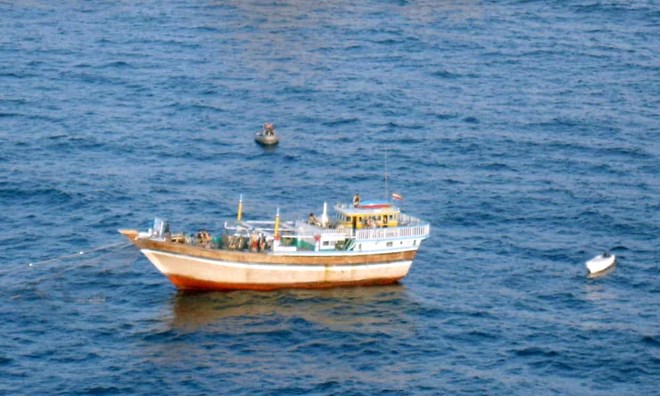SeafoodSource
By Shem Oirere
Saturday July 4, 2020

The Iranian fleet is thought to be six times the size of the Chinese tuna fleet licensed to sustainably fish Somalia’s waters. Photograph: US Navy/Getty Images
Somalia’s Ministry of Fisheries and Marine Resources has asked Iran to disclose more information on its fishing fleet’s activities in the Northwest Indian Ocean region after several of them were spotted in exclusive economic zones of Somalia and Yemen.
Somalia Fisheries Minister Abdilahi Warsame said there is increasing concern of illegal fishing in Somalia’s EEZ by foreign fishing vessels, the majority of which are from the Iranian ports of Konarak, Bandar-e, Tiyab and Ramin.
“The situation related to the presence of the Iranian fleets in Somali waters remains a longstanding concern of the Federal Republic of Somalia, and illegal, unreported, and unregulated fishing in Somalia waters constitutes a significant threat to food security, economic development, sovereignty and maritime ecology of Somalia,” Warsame said on Twitter.
The minister was responding to a new report from Global Fishing Watch and Trygg Mat Tracking, which used data collected between January 2019 and April 2020 to show how Iranian vessels have been operating, apparently without approval, inside the EEZs of Somalia and Yemen, two countries that have been entangled in longstanding, bloody civil conflicts.
The report, which was based on data sourced from Orbcomm, Spire, and ExactEarth, and which was authored by Global Fishing Watch Director Charles Kilgour and Trygg Mat Tracking Executive Director Duncan Copeland, said the situation “is likely one of the largest illegal fishing operations occurring in the world.”
Global Fishing Watch, a partnership between Google and the advocacy groups Oceana and SkyTruth, has been tracking incidences and hot spots of illegal fishing since it was launched in 2016. It collects data through automatic identification system (AIS) carried onboard many fishing vessels to help them detect nearby ships and avoid collision, as well as the vessel monitoring systems (VMS) of participating nations. AIS are also installed on drifting buoys to mark and track fishing equipment such as nets. For the 15 months under review, the study identified nearly 200 Iranian fishing vessels and net markers in Somali waters, while 208 were spotted in Yemen’s EEZ.
“If no license had been issued to these vessels, it indicates that illegal fishing by these fleets is a major concern,” the report said.
The Iranian vessels are likely to be using pelagic gillnets, which are legally limited to 2.5 kilometers long by the Indian Ocean Tuna Commission (IOTC) because they are responsible for high rates of bycatch, including sharks and turtles. But Pakistan, which had 10 fishing vessels and 21 net markers likely fishing illegally in Somali waters during the period under focus, could be using pelagic gillnets that are longer than 2.5 kilometers in length, according to Global Fishing Watch. The organization called for further investigation to confirm the gear type and the length of the nets used.
“It is not known if Somali and Yemen have limitations on these fishing gears. If so, then this may constitute further illegal activity,” the report said.
Kilgour and Copeland said they believe the number of vessels engaged in possible illegal fishing in Somalia and Yemen could much higher than what they were able to capture in the available data.
“Many targets identified in the satellite images do not correspond with an AIS signal, and the fleet appears to include both vessels using an AIS system and vessels without AIS,” they said in the report. “A significant challenge to clear identification of the vessels and their authorization status is the lack of public and transparent information on authorized vessels by any of the indicated flag states in question.”
Despite the fact that all countries that are contracting parties to IOTC are required to submit lists of their vessels authorized to target tuna and tuna-like species at least once a year, the report said this may not have happened with countries such as India, Iran, Pakistan, and Sri Lanka.
“There appears to be deliberate efforts to limit the information available on the individual vessels,” the report said.
It cited the example of Iran, which has 1,311 flagged vessel on the IOTC authorization list but “only 11 of these are identified by an individual vessel name.”
All the other vessels, the report says, are identified only by the word “vessel” and a number designation, such as “Vessel 1/1189.”
“The lack of accurate, public vessel information makes it extremely difficult for other IOTC contracting parties, coastal states and the broader international community to be able to identify any vessels flying under the Iran, Pakistan, India, and Sri Lanka flags, and to determine their authorization status – making enforcement efforts extremely complicated unless vessels are physically inspected and the authorization numbers or registration documents identified,” the report said.